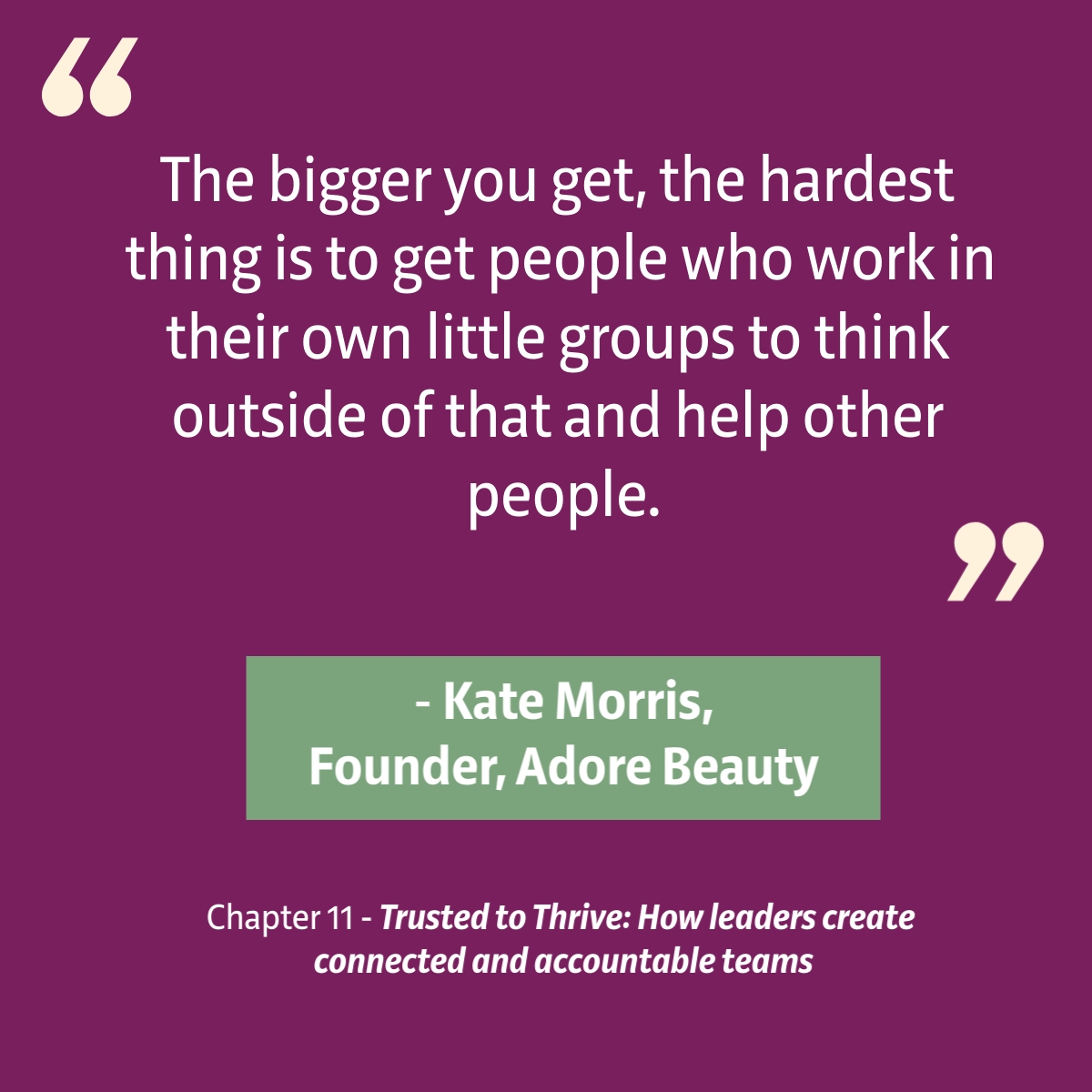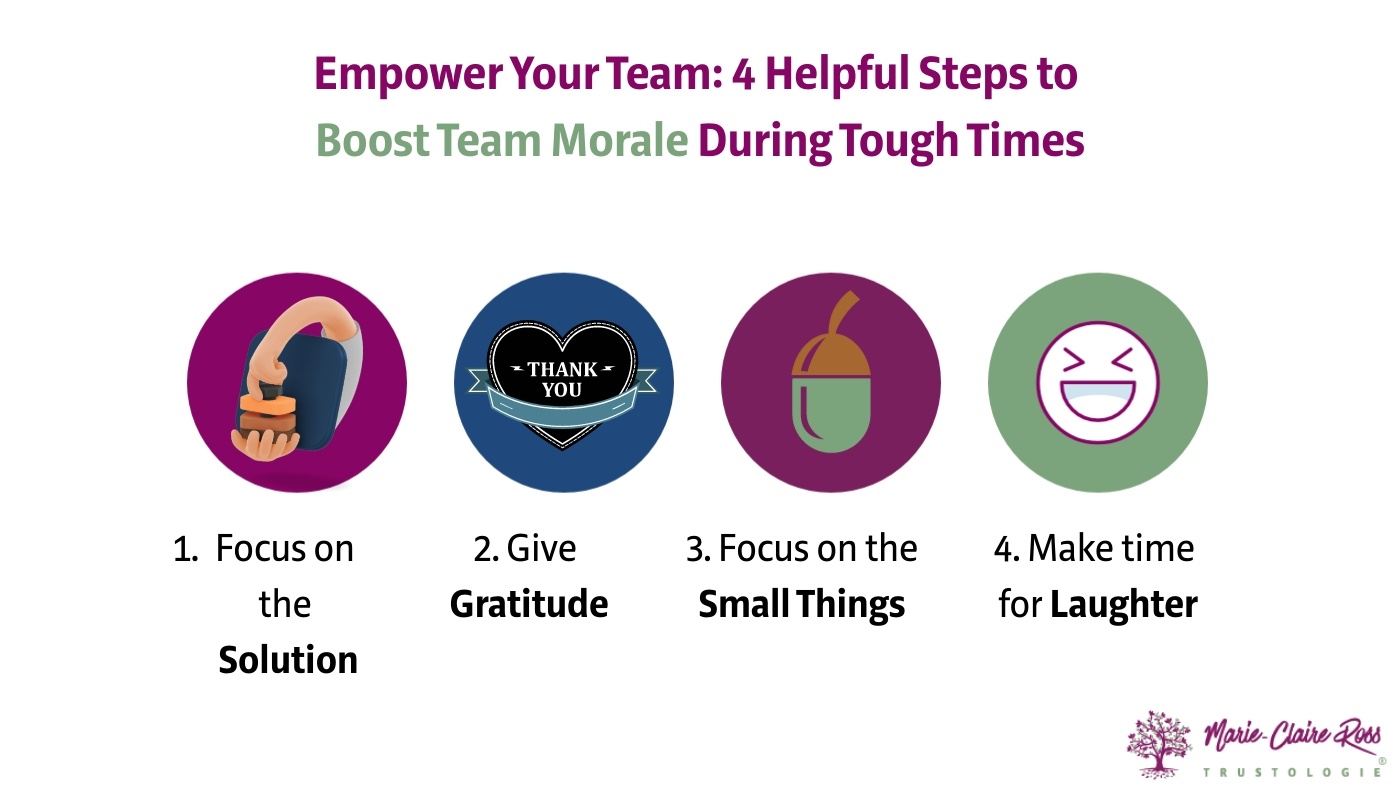
One of my darkest times as an entrepreneur was winning the contract to undertake all of the audiovisual requirements at Fashion Week. It involved filming and editing 57...
One of the common issues companies have to deal with are silos forming between departments.
Workplaces tend to have lots of interdependencies, complexity and unknowns that change daily. It becomes critical for all leaders in an organisation to provide their team with contextual understanding of their work environment. This not only reduces silos, but also helps people better understand how they make a difference to others in the organisation.
In my Chapter 11 of my book, Trusted to Thrive: How Leaders Create Connected and Accountable Teams, I unpack the importance of employees understanding beneficiaries. Improving intrinsic impact (how employees benefit personally from the work they do) is just as important as understanding the extrinsic impact (how others benefits from the work they do).
According to research by Francesca Gino, a behavioural scientist at Harvard Business School, there are both psychological and performance benefits to connecting employees to the beneficiaries of their work. In particular, interactions with the beneficiaries of one’s work can be highly motivating because they heighten workers’ perception of the impact of their tasks. It also helps employees work better with their peers.
Even successful start-ups that grow from a small cohesive team find that as they scale employees start to form separate teams with little interest in one another. It creates bottlenecks and a host of inefficiencies.
One organisation that found a solution is Adore Beauty, an Australian online beauty retailer. In 2000, Kate Morris and James Height co-founded the company from their garage in Melbourne. Through trials and tribulations they built their company into the behemoth that is now on the Australian stock exchange.
Back in 2016, I met Kate Morris, who was the CEO of Adore Beauty at the time. She attended one of the CEO roundtables I hosted for fast growing companies. Not long after, I caught up with her, as she was struggling with growth and the usual leadership team issues that plague a start-up founder. Three years later when we caught up again, she had turned things around and grown the company from 25 to 145 employees. In 2020, Adore Beauty had a successful IPO.
In my new book, I shared my interview and learnings from Kate over those three years, to find out how she managed the typical problems companies face when they go from one site to multiple. During this time. Kate found that it became hard for people to know everyone. As Kate explained 'Before, people in marketing could speak to people in the warehouse if they had questions because they would know someone. Now, they don't. As we have gotten bigger, we have had to work really hard to encourage teams to physically meet or have video calls.'

One of the strategies Kate introduced leveraged new starter inductions to help employees understand other teams they didn't see day-to-day. As Kate commented, 'As part of our induction process, even if people are working in the office, they spend a day at the factory doing pick and pack, just to meet people there and understand how everything works end-to-end. I find that when people don’t understand what another department does that’s when they get annoyed with them. They would say, ‘Why didn’t they do this?’ Now, marketing is aware of what is involved with warehousing putting a new product on the shelf at three pm on Monday because they know first-hand that’s their busiest day in the warehouse.'
But just getting employees to do work experience in another team wasn't enough. To further help teams understand one another at a deeper level, Morris found that getting teams to work together cross-functionally also improved contextual understanding.
She explained, ‘It’s been a useful thing to get other teams to work together at an offsite with brand and marketing teams sharing their KPIs so everyone understands what they are trying to perform to. So they realised that if they feature a product in marketing communication and the other brand team member is being measured on how many out-of-stocks they have, that, if they don’t give them a chance to order extra, then they will be out-of-stock and their performance will look bad. So then they could ask for their help and ask them, “I was thinking about you, does this work or would this be better?”'
In addition to getting teams together to better understand how their results are measured and how work gets done, Morris found that bringing cross-functional team leaders together regularly helped reduce silos and build trust. Morris added, ‘Get different cross-functional managers to meet twice a month and talk about what they are doing in their department so that fulfilment knows what production is doing. This team meeting is with the whole operations group and each function talks through their metrics. What’s increasing/decreasing? What do our costs look like? Then, they go around and get each functional head to talk about their initiatives related to broader strategy and where they are with that, as well as any new initiatives they wish to bring to the table.’
Of course, all of these practices seem easy to implement. But they require the focus and dedication of the CEO to role model and for each senior executive to oversee. It also has to occur in the right environment.
One of the things Kate noticed was that cross-functional team meetings only worked well in a relaxed atmosphere. If people were unfriendly or felt that they were being forced to work together they wouldn't openly share their progress, roadblocks and concerns in the spirit of helping one another achieve. It took some time for the teams to build trust with one another. But the effort was worth it. And Kate found that, ‘Getting together cross functionally brings forth a lot of good things that you normally don’t get if meeting to discuss the one area.’
Leaders who encourage team members to spend time with both external and internal customers help their organisation on many different levels. It ensures better service to paying customers, less frustration with colleagues and improves employee's motivation. It also strengthens people’s sense of belongingness and connection. Most of all, it helps employees to really understand how they make a difference to other people's lives increasing both the meaning of their work and job satisfaction.
For more tips like this, order a copy of my book, Trusted to Thrive.

One of my darkest times as an entrepreneur was winning the contract to undertake all of the audiovisual requirements at Fashion Week. It involved filming and editing 57...

Times are challenging, obstacles are tough, and uncertainties loom on the horizon. The economic landscape is evolving in real time and will keep changing in the weeks...